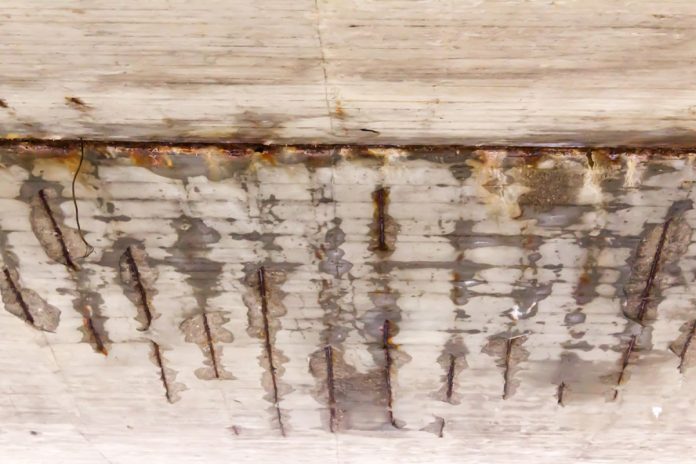
Many traditional reinforced concrete structures struggle in harsh conditions, particularly where water ingress is an issue. But, as James McDonald of Cementaid explains, a more sustainable future is possible
How often do we hear about the 100-year design life of, for example, a bridge, yet major structural repairs are required within 30 years?
Ordinary reinforced concrete subject to harsh conditions is not the durable material many believe it to be and the use of cement replacements and special cements have done little if anything to help.
About 30 years ago, epoxy-coated rebar was heralded as the answer to rebar corrosion, but this was short lived. Various other coating systems allegedly address this issue; unfortunately, such products either require regular recoating or have a short life due to being washed out of the concrete.
Over the past 25 years, there has been much hype over the use of stainless steel. Many wrongly believing that such steel was corrosion-proof. The problems with using stainless steel have been largely ignored: it is brittle and if you only use it where corrosion is most likely and attach it to ordinary steel, the ordinary steel will corrode as it will act as the sacrificial anode.
However, it is very important to understand the mechanism by which water passes through concrete. Some mistakenly assume that ‘low permeability’ is the key parameter. However, ordinary good quality concrete resists any appreciable flow of water under pressure, making the concrete stronger or denser is completely irrelevant. By increasing density, the pore and capillary network becomes finer and straighter, so far from slowing the passage of water, you may actually speed up the flow as we all remember from our school days in the laboratory when using the capillary tube.
The predominant mechanism of water movement through properly compacted concrete without defects is capillary absorption, which requires no hydrostatic pressure whatsoever. “Calculation of the water penetration depth during wetting showed that the speed of capillary absorption is of the order of a million times faster than permeability” *1.
In some structures, reinforcement corrosion will be limited to certain areas, for example, in the tidal zone of bridge supports where the constant wetting and drying cycle causes the build-up of salt in the concrete. There are numerous examples of this problem: the Öland Bridge repairs completed in 2005 after about 15 years in service and involving renovation work to the corroded pier supports in the tidal zone, replacement of 19 joints and restoration of the parapet walls cost “… twice the (total) cost of the original bridge at current prices”. The project manager is quoted as saying: “Buy cheap, repair expensively”.
In other structures, for example, a tunnel placed on the seabed, the whole structure in contact with seawater is potentially at risk due to the ‘hollow leg syndrome’. This is where chloride-rich water constantly flows from the wet to the dry face, the water evaporates on the dry face leaving the build-up of salt which, being acidic, destroys the alkaline coating around the rebar thus leaving it open to corrosion in the presence of oxygen and water, as the electrolyte to join cathode to anode. Again, there are numerous examples of this including the Mass Transit underground in Hong Kong and the Sydney Harbour road tunnel.
Where concrete structures are built in potentially corrosive environments, owners should be extremely wary of persuasion to use alternative products to those specified by the structural engineer, especially motivated by price.
“There is hardly anything in the world that some man can’t make just a little worse and sell just a little cheaper, and the people who buy on price alone are this man’s lawful prey” – John Ruskin.
Only proven products should be used as there are many examples of untried or inappropriate products that subsequently failed, or worse, caused major issues. For example, the use of high-alumina cement, aggregates containing pyrite and aggregates containing calcined dolomite.
If we are serious about ‘sustainability’, we need to address this issue and make concrete perform better. We may not be able to completely stop concrete structures deteriorating but we can significantly extend the life of such structures with proven products available here and now. However, decisions as to how to achieve durable concrete cannot be left to contractors whose only motivation is profit with no consideration of future maintenance, repair and replacement, the costs of which will dwarf the original cost of building the structure.
Everdure Caltite the extra ingredient for proven durability
Cast iron is not used in modern construction because it has a critical “deficiency”: it is brittle. However, adding a small amount of carbon (0.2%) gives us high tensile strength – steel. For additional enhancement, adding chrome gives stainless steel and so on. Everdure Caltite applies the same proven concept to concrete.
Everdure Caltite is a hydrophobic and pore-blocking liquid ingredient which is added to the concrete mix. It reverses normal capillary wick (sucking action) to produce ultra-low absorption concrete.
Ordinary high quality concrete is unsuitable for marine structures. It naturally absorbs water, moisture, and any deleterious salts in solution and provides the all-important electrolyte linking anodic and cathodic regions of the reinforcement.
Adding Everdure Caltite to normal concrete effectively transforms this deficiency, giving it properties with significant technical, commercial and environmental advantages.

17 year old Caltite concrete
47 year old Caltite concrete
The photos show concrete supports for a pipeline run across a tidal salt pan in South Australia where summer temperatures can reach 40ºC. To put this in perspective, the ground sulfate levels on this site were measured at 7.2g/litre and chlorides at 53g/litre. These exceed the worst possible cases indicated in BRE Special Digest 1 – (DS5 & DC4)
For more information contact Cementaid (UK) Limited, 1 Baird Close, Crawley, RH10 9SY. Tel. 01293 653900
Please note, this is a commerical profile
James McDonald
General Manager
Cementaid (UK)
Tel: 01293 653900













